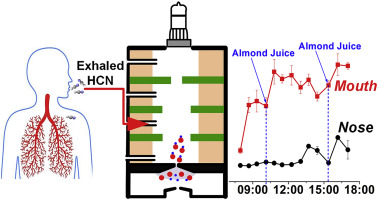当前位置:
X-MOL 学术
›
Anal. Chim. Acta
›
论文详情
Our official English website, www.x-mol.net, welcomes your feedback! (Note: you will need to create a separate account there.)
Highly selective and sensitive online measurement of trace exhaled HCN by acetone-assisted negative photoionization time-of-flight mass spectrometry with in-source CID
Analytica Chimica Acta ( IF 6.2 ) Pub Date : 2020-05-01 , DOI: 10.1016/j.aca.2020.03.035 Yuanyuan Xie 1 , Qingyun Li 1 , Lei Hua 1 , Ping Chen 1 , Fan Hu 2 , Ningbo Wan 3 , Haiyang Li 1
Analytica Chimica Acta ( IF 6.2 ) Pub Date : 2020-05-01 , DOI: 10.1016/j.aca.2020.03.035 Yuanyuan Xie 1 , Qingyun Li 1 , Lei Hua 1 , Ping Chen 1 , Fan Hu 2 , Ningbo Wan 3 , Haiyang Li 1
Affiliation

|
Exhaled hydrogen cyanide (HCN) has been extensively investigated as a promising biomarker of the presence of Pseudomonas aeruginosa in the airways of patients with cystic fibrosis (CF) disease. Its concentration profile for exhalation can provide useful information for medical disease diagnosis and therapeutic procedures. However, the complexity of breath gas, like high humidity, carbon dioxide (CO2) and trace organic compounds, usually leads to quantitative error, poor selectivity and sensitivity for HCN with some of existing analytical techniques. In this work, acetone-assisted negative photoionization (AANP) based on a vacuum ultraviolet (VUV) lamp with a time-of- flight mass spectrometer (AANP-TOFMS) was firstly proposed for online measurement of trace HCN in human breath. In-source collision-induced dissociation (CID) was adopted for sensitivity improvement and the signal response of the characteristic ion CN- (m/z 26) was improved by about 24-fold. For accurate and reliable analysis of the exhaled HCN, matrix influences in the human breath including humidity and CO2 were investigated, respectively. A Nafion tube was used for online dehumidification of breath samples. Matrix-adapted calibration in the concentration range of 0.5-50 ppbv with satisfactory dynamic linearity and repeatability was obtained. The limit of quantitation (LOQ) for HCN at 0.5 ppbv was achieved in the presence of 100% relative humidity and 4% CO2. Finally, the method was successfully applied for online determination of human mouth- and nose-exhaled HCN, and the nose-exhaled HCN were proved to be reliable for assessing systemic HCN levels for individuals. The results are encouraging and highlight the potential of AANP-TOFMS with in-source CID as a selective, accurate, sensitive and noninvasive technique for determination of the exhaled HCN for CF clinical diagnosis and HCN poisoning assessment.
中文翻译:

通过具有源内 CID 的丙酮辅助负光电离飞行时间质谱法对呼出的痕量 HCN 进行高选择性和灵敏的在线测量
呼出的氰化氢 (HCN) 已被广泛研究作为囊性纤维化 (CF) 疾病患者气道中铜绿假单胞菌存在的有希望的生物标志物。其呼气浓度分布可为医学疾病诊断和治疗程序提供有用的信息。然而,呼吸气体的复杂性,如高湿度、二氧化碳 (CO2) 和痕量有机化合物,通常会导致定量误差、使用一些现有分析技术对 HCN 的选择性和灵敏度差。在这项工作中,首次提出了基于真空紫外 (VUV) 灯和飞行时间质谱仪 (AANP-TOFMS) 的丙酮辅助负光电离 (AANP),用于在线测量人体呼吸中的痕量 HCN。采用源内碰撞诱导解离 (CID) 来提高灵敏度,特征离子 CN- (m/z 26) 的信号响应提高了约 24 倍。为了准确可靠地分析呼出的 HCN,分别研究了人体呼吸中的基质影响,包括湿度和 CO2。Nafion 管用于呼吸样本的在线除湿。在 0.5-50 ppbv 的浓度范围内获得了具有令人满意的动态线性和重复性的基质适应校准。在 100% 相对湿度和 4% CO2 存在下,HCN 的定量限 (LOQ) 为 0.5 ppbv。最后,该方法成功应用于人口鼻呼出HCN的在线检测,经证实,经鼻呼出的 HCN 可可靠地评估个体的全身 HCN 水平。结果令人鼓舞,并突出了具有源内 CID 的 AANP-TOFMS 作为一种选择性、准确、灵敏和非侵入性技术的潜力,用于测定呼出的 HCN,用于 CF 临床诊断和 HCN 中毒评估。
更新日期:2020-05-01
中文翻译:

通过具有源内 CID 的丙酮辅助负光电离飞行时间质谱法对呼出的痕量 HCN 进行高选择性和灵敏的在线测量
呼出的氰化氢 (HCN) 已被广泛研究作为囊性纤维化 (CF) 疾病患者气道中铜绿假单胞菌存在的有希望的生物标志物。其呼气浓度分布可为医学疾病诊断和治疗程序提供有用的信息。然而,呼吸气体的复杂性,如高湿度、二氧化碳 (CO2) 和痕量有机化合物,通常会导致定量误差、使用一些现有分析技术对 HCN 的选择性和灵敏度差。在这项工作中,首次提出了基于真空紫外 (VUV) 灯和飞行时间质谱仪 (AANP-TOFMS) 的丙酮辅助负光电离 (AANP),用于在线测量人体呼吸中的痕量 HCN。采用源内碰撞诱导解离 (CID) 来提高灵敏度,特征离子 CN- (m/z 26) 的信号响应提高了约 24 倍。为了准确可靠地分析呼出的 HCN,分别研究了人体呼吸中的基质影响,包括湿度和 CO2。Nafion 管用于呼吸样本的在线除湿。在 0.5-50 ppbv 的浓度范围内获得了具有令人满意的动态线性和重复性的基质适应校准。在 100% 相对湿度和 4% CO2 存在下,HCN 的定量限 (LOQ) 为 0.5 ppbv。最后,该方法成功应用于人口鼻呼出HCN的在线检测,经证实,经鼻呼出的 HCN 可可靠地评估个体的全身 HCN 水平。结果令人鼓舞,并突出了具有源内 CID 的 AANP-TOFMS 作为一种选择性、准确、灵敏和非侵入性技术的潜力,用于测定呼出的 HCN,用于 CF 临床诊断和 HCN 中毒评估。



























 京公网安备 11010802027423号
京公网安备 11010802027423号